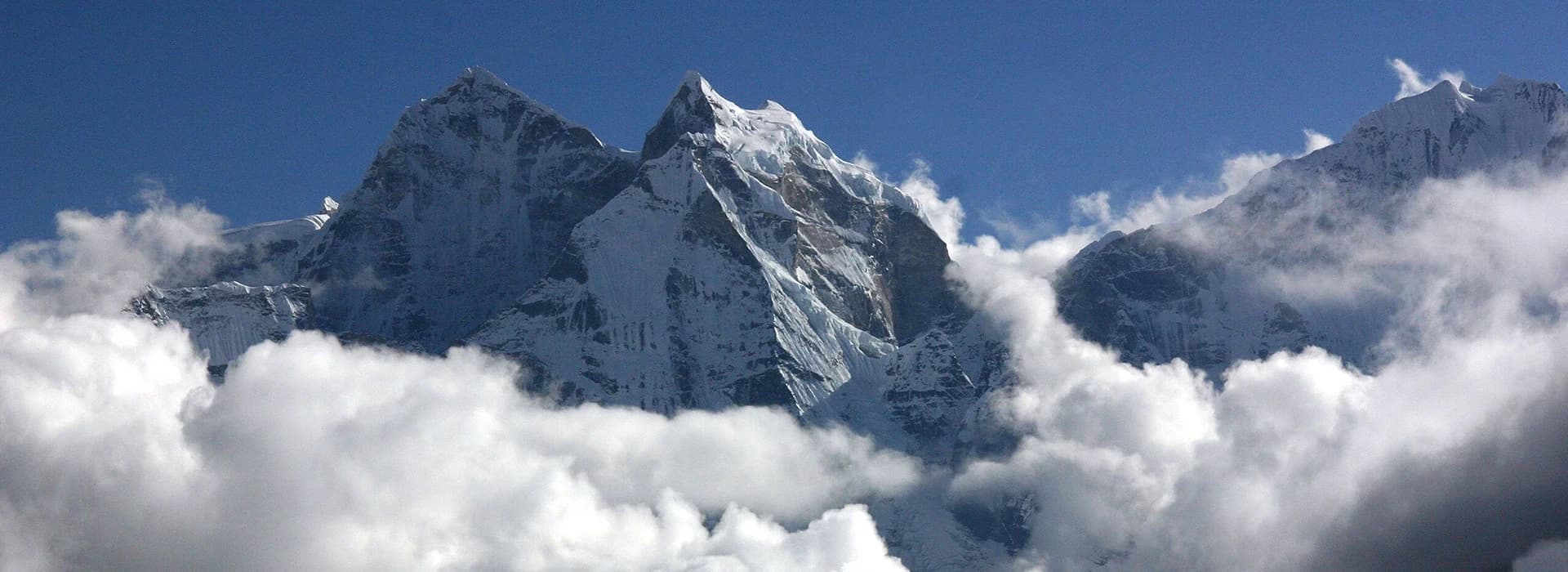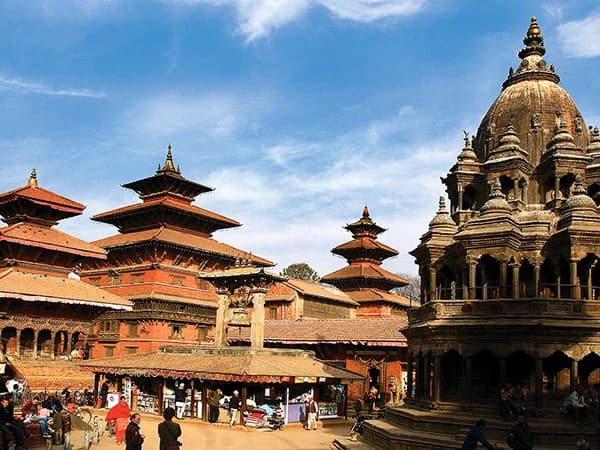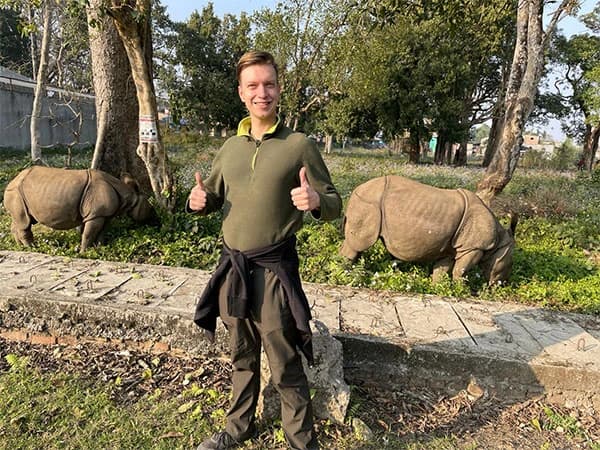Lobuche East Peak Climbing is one of the most famous and adventurous trips in Nepal's Khumbu/Everest region that summits the Lobuche Peak itself at an altitude of 6,119 m above sea level. Nestled in the heart of the Khumbu region, Lobuche offers an equally demanding and thrilling experience, granting you an adventure that comes once in a lifetime.
Categorized as a grade B mountain peak in Nepal by the Nepal Mountaineering Association (NMA), Lobuche has two magnificent ridges: east at 6,119 m and west at 6,114 m; hence, it is considered one of the best beginner-friendly, comparatively less technical climbing peaks that provides you with an outstanding panorama of Everest, Lhotse, Nuptse, Ama Dablam, Makalu, and many other Himalayan giants on making it to its top.
The journey to here, Lobuche East, typically begins with an adventurous flight to Lukla from Kathmandu, followed by alpine jaunting through the legendary Sherpa dwellings of Namche Bazaar, Tengboche, Pheriche, and Lobuche, heading to Everest Base Camp and Kala Patthar in the first half sections. After that, you will officially start to traverse one of the sought-after peaks of the Everest Himalayan region, passing via Louche Base Camp, High Camp, and finally to the summit.
All of the alpine jaunting and climbing expeditions take place in the shadow of Everest in relatively more suitable Himalayan surroundings, offering you a no lesser experience of summiting the largest mountain range on the planet, Mt. Everest (8,848 m), gratifying to the core, where trekkers and climbers not only get to acclimatize to the altitudes but also marvel at Sherpa culture and its stunning Himalayan landscapes.
Therefore, Lobuche East Peak Climbing is a go-to choice for a simple novice climbing venture for veteran mountaineers that culminates in a true sense of accomplishment that not only tests the physical abilities of adventurers but also grants a deep connection with the neutral, cultural, and spiritual essence of the Everest region, leaving you with a life-lasting impression in the hearts and souls of everyone partaking in it.
Highlights
- Magnificent mountain flight to Lukla from Kathmandu.
- Get to traverse the original Everest region trekking route for several days.
- Pass through the traditional Himalayan villages of Namche, Tengboche, Dingboche, and many others.
- Side trips to several top-notch viewpoints in the Everest region with unmatchable views of Everest, Lhotse, Nupste, and others, such as Khumjung, Syangboche Airport, Khungde, Kala Patthar, and Lobuche Peak itself.
- Reach to the base of the tallest mountain peak globally, Mt. Everest (8,848 m).
- Traverse along one of the natural havens of Nepal, the Sagarmatha National Park, its suspension bridges, Khumbu glaciers, and mountains rich in biodiversity.
- Get enlightened about the lifestyle of the legendary Sherpa people and their long-established culture, traditions, and customs.
- Catch blessing at the largest Buddhist monastery in the region, Tengboche and Khumjung, which is believed to possess the skull of the mythical big foot ‘Yeti’.
- Awe-inspiring Himalayan journey to the Lobuche Peak (6,119 m) and many more.
What makes the climbing journey to Lobuche East Peak special?
The Lobuche East Peak climb offers a unique combination of stunning scenery, diverse culture, and some technical challenges in Nepal's Everest Himalayas that follow the classic trekking route to the Everest Base Camp. Trekking takes five to seven hours a day and can last anywhere from two weeks or more while ascending and getting back to the summit can take eight to ten hours.
This well-liked hiking route goes through famous Sherpa villages, providing a window into the history and culture of the locals and their customs and warmth for both seasoned hikers and novices, alongside the adventure of reaching the top of Lobuche, Everest Base Camp, and Kala Patthar, perched up in high altitude, making it an ideal destination for anyone with notable physical fitness, adequate preparation, and appropriate packing, promising an amazing adventure with:
An adrenaline-rushing flight to Luka Airport in the Everest region
The Lukla airport, another name for Tenzing-Hillary Airport, at an altitude of 2,845 m (9,334 ft), is the traditional trekking point for the Everest region, whether you are seeking a spiritually transforming journey to Tengbohce called Everest View Trekking, a combined expedition to Gokyo Cho La Pass Everest Base Camp, or the Everest Base Camp Trekking and Island Peak climbing, including that to climb Lobuche East Peak.
Famous for its short runway, which is only about 527 m (1,729 ft), the flight to the Lukla airport offers jaw-dropping views of a variety of landscapes, from lush green valleys to stunning snow-capped peaks, cascading waterfalls, and traditional Nepalese villages, and hence is often described as one of the most thrilling and nerve-wracking parts for outdoor adventure lovers, while the thin air at high altitude fills you with a sense of anticipation and excitement, marking the beginning of a life-changing journey to the Lobuche East Peak Climbing.
The enriching Sherpa culture and the spiritual center of the Everest region, Tengboche Monastery
Throughout the climbing trail to Lobuche East Peak, you will make your way through several typical mountain villages scattered along the route, particularly predominated by Sherpa people, who are renowned globally for their mountaineering skills, offering an amazing insight into their daily lives, deep-rooted traditions, spiritual richness, and adaptability to the arduous mountainous surroundings.
A large population of these Himalayan locals, Sherpa, practice Tibetan Buddhism characterized by vibrant prayer flags, stone-carved mani walls, monasteries, and stupas and celebrate their distinctive festivals like Losar (Tibetan New Year), Mani Rimdum, and several other celebrations fostering community bonds and spiritual devotion in the Khumbu/Everest region, among which the Tengboche monastery stands out as the largest monastery of the area.
Nestled amidst towering peaks, the Tengboche monastery serves as a spiritual oasis at an altitude of 3,867 m/12,687 ft and is the most significant Buddhist monastery in the Everest region, a perfect palace to find solace and blessing for your safe journey to the Lobuche East Peak, which is also home to hundreds of monks, while the views of Ama Dablam, Everest, Nuptse, Thamserku, and Lhotse further enhance the tranquil ambiance of the monastery and its encompassment.
The UNESCO World Heritage Site, the Sagarmatha National Park, and the majestic Himalayan peaks
The adventurous Himalayan journey to Lobuche East Peak Climbing takes place through the UNESCO World Heritage Site of Sagarmatha National Park, which covers an area of 1,148 square kilometers and is named after the Nepali name of Mt. Everest, Sagarmatha, in the Solukhumbu District of Nepal, which has meticulously preserved the natural, cultural, and religious heritage of the region.
Established in 1976, the Sagarmatha National Park features a wide array of landscapes and biodiversity, including mesmerizing mountainous terrain, glaciers, and deep river valleys along the Dudh Koshi River, alongside some of the most iconic Himalayan peaks such as Lhotse (8,516 m), Cho Oyu (8,188 m), Thamserku (6,608 m), and the highest peak in the globe, Mt. Everest (8,848 m).
Trekkers and climbers on the way to Lobuche East Peak are treated to these awe-inspiring vistas of the great Himalayan ranges framed by the unique flora and fauna of the Everest region meandering along the scenic forests of rhododendron, gradually leading you to alpine meadows, sheltering the elusive snow leopard, Himalayan Tahr, red panda, and Himalayan black bear. Besides the Himalayan locals, Sherpa showcases the unparalleled coexistence of nature and the traditional Sherpa culture.
The adventurous alpine ascend to the EBC, Kala Patthar, and Lobuche Peak
The Himalayan journey to the Lobuche East Peak of Nepal includes an adrenaline-rushing alpine ascent to Everest Base Camp (EBC) and Kala Patthar, adding layers of challenge and excitement to the expedition and offering a comprehensive and exhilarating experience in the center of the Himalayas.
Located at an altitude of 5,364 m (17,598 ft), reaching Everest Base Camp itself is a significant milestone achievement, passing through the unparalleled beauty of the icy formation and close-up sight of the formidable Khumbu Icefall, and lastly, reaching the footstand of the highest mountain in the world, Mt. Everest, where you can witness the bustle of climbers preparing to summit the peak, especially during the peak climbing seasons (spring and fall).
Similarly, at an altitude of 5,545 m (18,192 ft) above sea level, Kala Patthar is a spectacular viewpoint of the Everest region, which is famous for its unobstructed panoramic views of Mount Everest and surrounding snow-capped peaks such as Nuptse and Lhotse. The sunrise and sunset from here are particularly other-worldly when the first ray of sunlight fills the atmosphere with golden hues.
Last but not least, Louche Peak at 6,119 m/20,075 ft is the maximum elevation gain of your entire journey, flanked by the shimmering Lobuche glacier to the east and the Khumbu Glacier further enhancing the immeasurable experience, whether it is on excellent mountain vistas or the most serene environment to reflect in yourself, unveiling a new gem in every step you take, worth a trip.
Ample acclimatization and exploration en route to the Lobuche East Peak
This Himalayan odyssey to the Everest region to summit Lobuche East Peak is mostly through 5,000 m in remote parts of the Nepalese Himalayas with potential risk of altitude mountain sickness (AMS) or altitude sickness, any reputed travel, trekking, climbing, and tour organizers such as Ammonite Adventure. includes ample of buffer days that let you proper acclimatization and exploration without missing any of the highlights of the Everest region to be discovered.
The trip to Lobuche East Peak makes regular pauses at Namche, Phakding, Tengboche, and several other top-notch Himalayan villages and valleys, ensuring you get plenty of opportunity for a pleasing exploration and acclimatization. While Tengboche monastery has one of the most gorgeous Himalayan views of the surrounding peaks, Namche organizes a Saturday local market, giving you insider insight into local life.
The ascend continues through rough and stunning Himalayas as you get closer and closer to Lobuche, where trekkers and climbers are rewarded with the glazing sight of the Khumbu glacier, Everest memorials, and the Everest region’s natural beauty.
The 17 Day itinerary and trekking route to Lobuche East Peak Climbing
The 14-day Lobuche East Peak Climbing itineraryand hiking route begins in Kathmandu with a flight to Lukla, then goes through Phakding, Namche Bazaar, Tengboche, Pheriche, Lobuche, Gorakshep with an afternoon trek to EBC, and Lobuche with a morning hike to Kala Patthar.
The trekkers from Louche then head towards Lobuche Base Camp and High Camp to push for the summit, navigating demanding terrain. After the thrilling summit experience, the return trek to Kathmandu begins, followed by descent to Lobuche, Pangboche, Namche, Lukla, and Kathmandu, denoting the end of the journey.
In between this 17-day itinerary and trekking route, you will be granted acclimatization days in Namche and Pheriche, and at Ammonite Adventure, you will be under the careful supervision of our local mountain Sherpa guide with years of collective expertise in guiding through their land, culture, and years of preserved traditions and customs in the raw wilderness.
Therefore, this 17-day itinerary set by us is one of the best hiking routes to explore the Everest region that reaches the Everest Base Camp (EBC) and summits Lobuche East Peak, successfully considering every essential need, deed, and preference for an achievable Himalayan exploration.
The 17-Day Lobuche East Peak Climbing Cost for 2026/2027
The cost of a Himalayan voyage to climb Lobuche East Peak can vary massively and can be managed accordingly based on individual preferences and budgets, along with the season you are heading for the expedition, the level of services you are interested in relishing, group size, and the trekking company you have chosen for the tour.
Nonetheless, if you are seeking an incredible journey to the Nepalese Himalayas around the top of the world, Mt. Everest, and the Lobuche East Peak in the holidays of 2026/2027, it would be good to separate from USD 2,500 to USD 4,500 per person, where our standard climbing package comes around at USD 2,051. Contact us now to book your seat!




